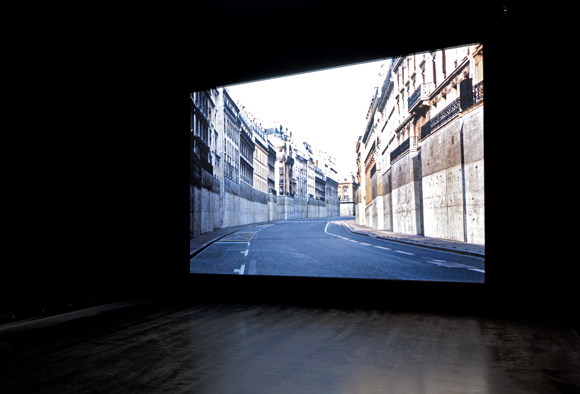|
Viderparis, 1998-2001
Nicolas Moulin

The work Viderparis is based on a projection in which unusual, fictional street scenes from a depopulated Paris of the future are displayed in random order. The artist reworked fifty of his own photographs of the city, painstakingly removing any trace of human life – buildings at street level are concreted shut, there are no cars, no street signs, no trees to be seen. An oppressive soundtrack accompanies this imaginary walk, where the viewer becomes an actor. The atmosphere the artist is aiming for is that of a science-fiction film – the work serves as a metaphor for the “clinical death” which humanity is headed for, according to Moulin. However, the random sequencing of the images ensures that – unlike in a film – there is no story with a beginning and an end to be perceived. The title “Viderparis” contains the French vider – to empty – but at the same time reminds us of the Latin videre – to see.
Nicolas Moulin graduated from the art academy in Cergy-Pontoise. Architecture and landscape are central themes in his artistic production. Since his childhood, his visual imagination has been influenced by the history of the twentieth century, particularly that of the Soviet Union, as well as science fiction literature. For a number of years Moulin has been building a large collection of landscape images, some of which he now presents on the Internet.
Conservation measures
Viderparisconsists of a sequence of 50 digital images, projected on a digital video projector, with the images displayed in random order using special software. The Musée d’Art moderne et contemporain de Strasbourg (MAMCS) does not have equipment set aside solely to show this work. However, the basic parameters of display are strictly laid down by the artist. Among other things, Moulin insists on the use of software which ensures that the transition between the individual images is both random and gentle. Further parameters stipulate the required duration for the projection of individual images (32 seconds) and the sound, which should be audible throughout.
For this case study, the core of the conservation plan lies in the development of an information-preservation strategy for MAMCS. This will outline instructions for the physical storage of storage media, and for redundant data backup. (see the glossary).
Today, MAMCS only owns the images of Viderparis in JPEG file format, a compressed image format. When the work was given to the museum, Moulin handed over the data on CD-R (Compact Disc Recordable), an optical storage medium. The artist has now offered to give the files in the uncompromised TIFF format, which can serve as MAMCS’s “master copy”, from which any future exhibition copies can be made.
Photo: ONUK
|



